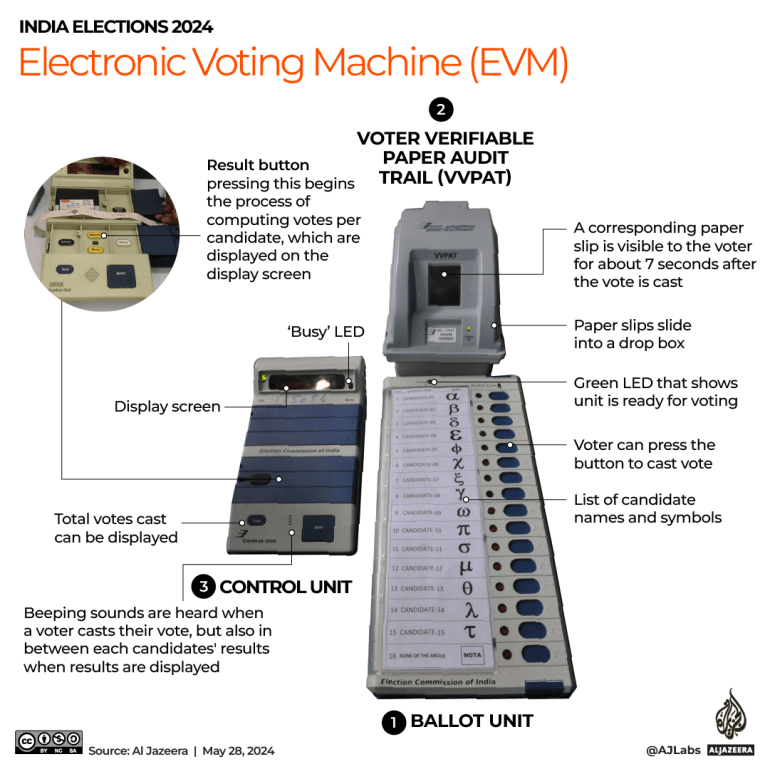Here’s how votes for India’s Lok Sabha polls will be counted using EVMs on June 4.
Voters have braved soaring temperatures to cast their ballots, with the seven phases – April 19, April 26, May 7, May 13, May 20, May 25 and June 1 – recording turnouts of 66.1, 66.7, 61.0, 67.3, 60.5, 63.4 and 62 percent, respectively. An estimated 969 million people were registered to vote. Ballots were cast using electronic voting machines (EVMs).
At stake are 543 seats in the Lok Sabha – the lower house of India’s Parliament. Votes will be counted on Tuesday, June 4.
Here’s how vote counting for elections works:
What time will votes be counted for India’s 2024 election?
Counting for all constituencies will begin at 8am (02:30 GMT) on Tuesday, June 4.
What are EVMs?
EVMs have been used in India’s elections since 2004 instead of paper ballots.
The Election Commission of India (ECI) developed these machines in collaboration with Bengaluru-based Bharat Electronics Ltd and Hyderabad-based Electronic Corporation of India Ltd, both government-owned companies. EVMs are battery-powered, so electricity is not needed for their functioning. They are not connected to the internet.
An EVM comprises two parts, which are connected through a cable:
- Control unit: It is operated by the polling officer at the polling booth. It has a “ballot button” which lights up a green LED on the other unit of the EVM, indicating the machine is ready for voting. It shows a “Busy” light while a vote is being cast. A “Close” button allows no more votes to be cast and a “Clear” button removes all data. A section displays the total number of votes cast.
- Balloting unit: It is kept in the voting compartment at the polling booth. The candidates’ names and symbols are fed into this unit, with a blue button next to each name. The unit also facilitates braille script to enable visually impaired voters to cast their votes without external help. Voters register their votes by pressing the blue button next to their candidate of choice. After the vote is cast, a beep sound goes off on the control unit.
Who oversees vote counting?
The ECI appoints a returning officer (RO) for each parliamentary constituency, making them responsible for vote counting.
An RO is supported by assistant returning officers (AROs), who are responsible for counting in the assembly segments falling under the respective parliamentary constituency. Each parliamentary constituency is divided into assembly segments corresponding to the constituencies in the respective state assemblies. Most parliamentary constituencies typically consist of six or seven assembly constituencies.
How are votes counted?
- As voting ends, the EVMs are sealed and stored in a strongroom in the parliamentary constituency. On the day of counting, the EVMs are taken out and unsealed in the presence of representatives from all participating political parties.
- Vote counting begins with the RO counting votes through postal ballots. The counting of EVM votes begins 30 minutes after the postal ballot count. Only the control units of the EVMs are required during the counting.
- Since there are several assembly constituencies within a parliamentary constituency, vote counting for each assembly segment takes place in a single hall where 14 tables are set up and control units of EVMs are distributed among the tables.
- The number of halls or tables can be increased if there is a large number of candidates. But it requires the electoral body’s prior permission. Counting can also take place in more than one location within the assembly constituency under the supervision of an ARO.
- Before counting, several checks are carried out to ensure that the control units are sealed, assigned correctly and functioning properly.
- In each round, votes registered in 14 EVMs are counted and the results are announced and written on a blackboard attached to each table before the next round of counting.
- The votes are counted by counting supervisors and counting assistants on each table, who are appointed by the RO through a randomisation process.
- The control unit of the EVM contains a “Results” button to display the number of votes each candidate received. It also shows the total number of candidates per constituency.
- When the Results button is pressed, the EVM displays votes secured by candidates one by one, indicated by beep sounds. The control unit shows “End” after the candidates’ vote numbers are displayed.
What is the VVPAT system?
This ECI introduced the Voter Verifiable Paper Audit Trail (VVPAT) system in 2013 to build voters’ confidence in the EVMs.
A VVPAT is connected to the control unit and the balloting unit of an EVM through cables. After a voter casts their vote, the VVPAT generates a corresponding paper slip, which is visible to the voter for about seven seconds to confirm that the vote was cast properly. These slips then fall into a drop box.
The Congress and some other opposition parties have been demanding that VVPAT slips be counted to tally votes for all polling stations across the country as a measure against vote rigging. The ECI has rejected the demand. However, the Supreme Court of India has directed the poll body to match the VVPAT slips from five randomly selected assembly segments with results from respective EVMs.
When will the election results be announced?
Initial trends and subsequent results start coming in soon after the counting begins. The final results of India’s general election will likely be announced on the night of June 4 or the morning of June 5.
Where to check India’s 2024 Lok Sabha election results?
The ECI will publish the results on its website. Al Jazeera will also be bringing you live results, updated with the latest from the ECI, on June 4.
